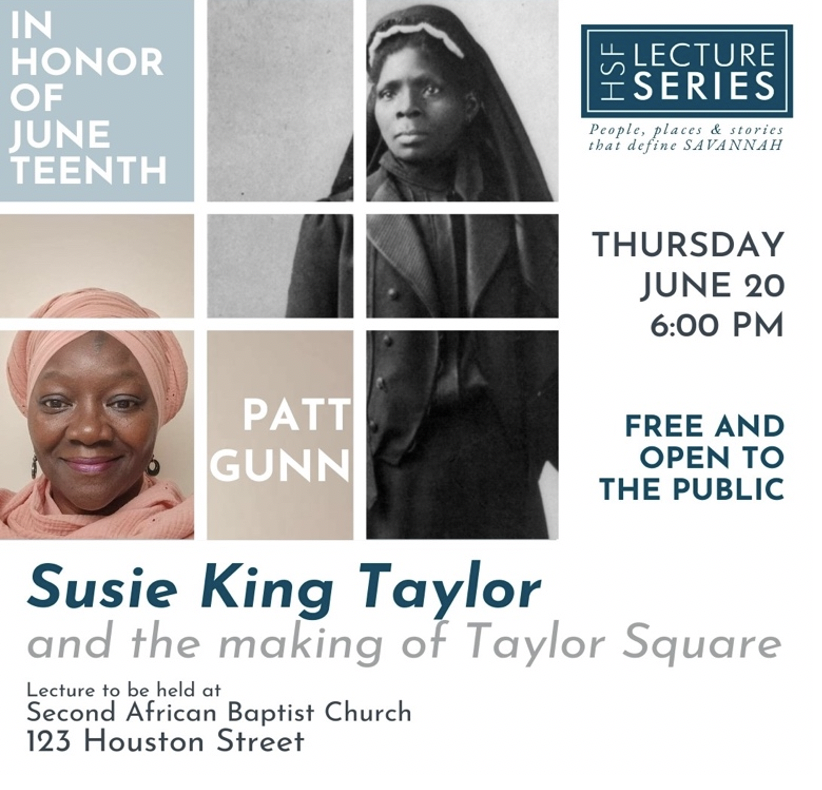PATT GUNN – "Sistah Patt" to friends – is perhaps Savannah's preeminent activist devoted to protecting and preserving the legacy and spirit of local Black history and Gullah culture.
In any case, she is certainly the most effective: Gunn spearheaded the successful effort to remove the name of former Vice President and ardent slavery supporter John Calhoun from Calhoun Square, as well as the subsequent effort to rename the square for local Black educator and nurse Susie King Taylor.
Gunn's passion is sharing her history and culture, with an eye toward truth-telling, reconciliation, healing and repair from the Trans-Atlantic Slave Trade. She also runs one of the best local history tours through her company Underground Tours of Savannah.
An engaging storyteller as well as a highly knowledgeable scholar, Gunn will give a free lecture at 6 p.m. this Thursday, July 20, at the Second African Baptist Church on Houston Street, "Susie King Taylor and the Making of Taylor Square."
The event is made possible by the Historic Savannah Foundation and the Davenport House Museum.
We spoke to the delightful Gunn last week.
Everyone can read about the literal history of Juneteenth on Wikipedia, the dates and facts. But I'm more interested in its emotional importance. What does Juneteenth mean to you on a human level?
Oh, I sometimes think back to the first time we had a commemoration of it in Savannah, back in 2008 at the corner of 41st and Habersham. Most people didn’t really know what Juneteenth even was then.
I think the importance of Juneteenth is about the acknowledgement of slavery, along with an apology for it. When we talk about slavery, we ask ourselves, what do we want to get from this discussion? What is the purpose of talking about it?
And the answers are, acknowledgment and apology. That’s worth more than any amount of money.
Was Susie King Taylor the first go-to choice for the square's new name, or was that more of a gradual process?
It wasn’t so much about who it was named after as it was about doing the right thing. We realized early on that we really needed to do this more for the people living today.
There were other candidates with the same amount of qualifications. I mean, the veteran who was killed? [Maj. Clayton Carpenter.] That was powerful. So you could say that Susie King Taylor had some stiff competition.
Why is Taylor so important? What do you want people to know about her?
She’s an American she-ro. She represents resilience and courage. If you’re looking for one person to inspire those of a younger generation, whether in high school or elementary school, she’s the best example you could ever give them.
She was born into slavery, then freed. She was never acknowledged for her work during her lifetime, never received a dollar in pension. But she kept doing what she was doing.
She had to go out of her native South all the way to Boston to sort of reinvent herself, to get any recognition at all. She worked as a nurse alongside Clara Barton in Boston, and they became friends. She is buried not in Savannah, but in Boston.
Her tribulations didn’t end with freedom from enslavement. Her son became ill after she had moved to Massachusetts. She took a train to come back down South to see him, but that old segregation kicked in. This woman who had nursed literally hundreds of American soldiers was not allowed to come back to the South to see her dying son!
I was up there in Boston recently, and I pledged not to leave until I had visited her gravesite and honored her. The Mayor actually helped me locate her burial site.
I visited her there, performed a libation at her burial ground, and I promised Susie King Taylor that we’d eventually make a monument to her in Savannah, in addition to the square, so people living here and visiting here would know all about her.
Tell us what people can expect from your free talk this week.
It is about the step-by-step process of the making of Taylor Square, about that whole process from beginning to end. We know now from experience that a process like this has to begin with civic engagement. This is collective work, it’s not the work of one individual.
That was my chief personal lesson from all this – that you can’t do it all on your own, you have to work as a collective, as a community.
We could not have done this without the neighbors on the square. We originally came to them with the names Sankofa and Jubilee. You remember we initially identified two squares for renaming, the two that were built on old Black burial grounds.
The neighbors were largely open to the idea of renaming the square, but they said they thought it should continue to be named after a person. We said, we’ve got just the perfect person! And they fell in love with the idea of naming the square after Susie King Taylor.
In the end it was the neighborhood that made the decision. The neighbors went out and got the required 51 percent of people residing near the square to support the proposal to rename it. I said early on that I couldn’t be the one to do it. I had already begun receiving threats.
People threatened you?!
Yes, things like, “you better not change the name of that square.” So we thought it was best that I not be the one going door-to-door. You don’t know who’s behind that door or what they’re going to do.
Jim, I spent 32 years working with the ACLU and for social justice. I’ve had people try to run me out of town before. I’ve had the KKK try to run me out of town. So this was a piece of cake by comparison.
You don't impress me as someone who is easy to discourage.
I have always said, all you can do to me is take my life! But the work we’re doing here is raising up people, a new generation. And that’s how you do it. That’s the work. That’s called building a movement.
So what's next for you? Any similar renaming projects?
People are always asking me that. “Sistah Patt, are you going after another square?” The answer is, no, I’m not. I’ve got a book to finish!
But I do think what we did was provide the community with the best model moving forward, not just for squares but for any public space. The people own these public spaces.
My mother passed in 2003. My mom helped desegregate the public schools here. I like to think she’s smiling down from above. This is the kind of work that she always pushed us to do. When people ask me about my motivation, I always tell them I get it from another generation that came before me.
Historic Savannah Foundation will host a special discussion about “Susie King Taylor and the Making of Taylor Square” as part of the 2024 Historic Savannah Foundation Lecture Series, “The People, Places and Stories That Define Savannah,” on Thursday, June 20 at 6 p.m. at the historic Second African Baptist Church, located at 123 Houston Street. This event, which is presented in collaboration with the Davenport House Museum, is free and open to the public


